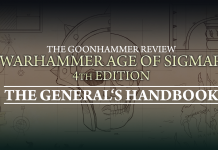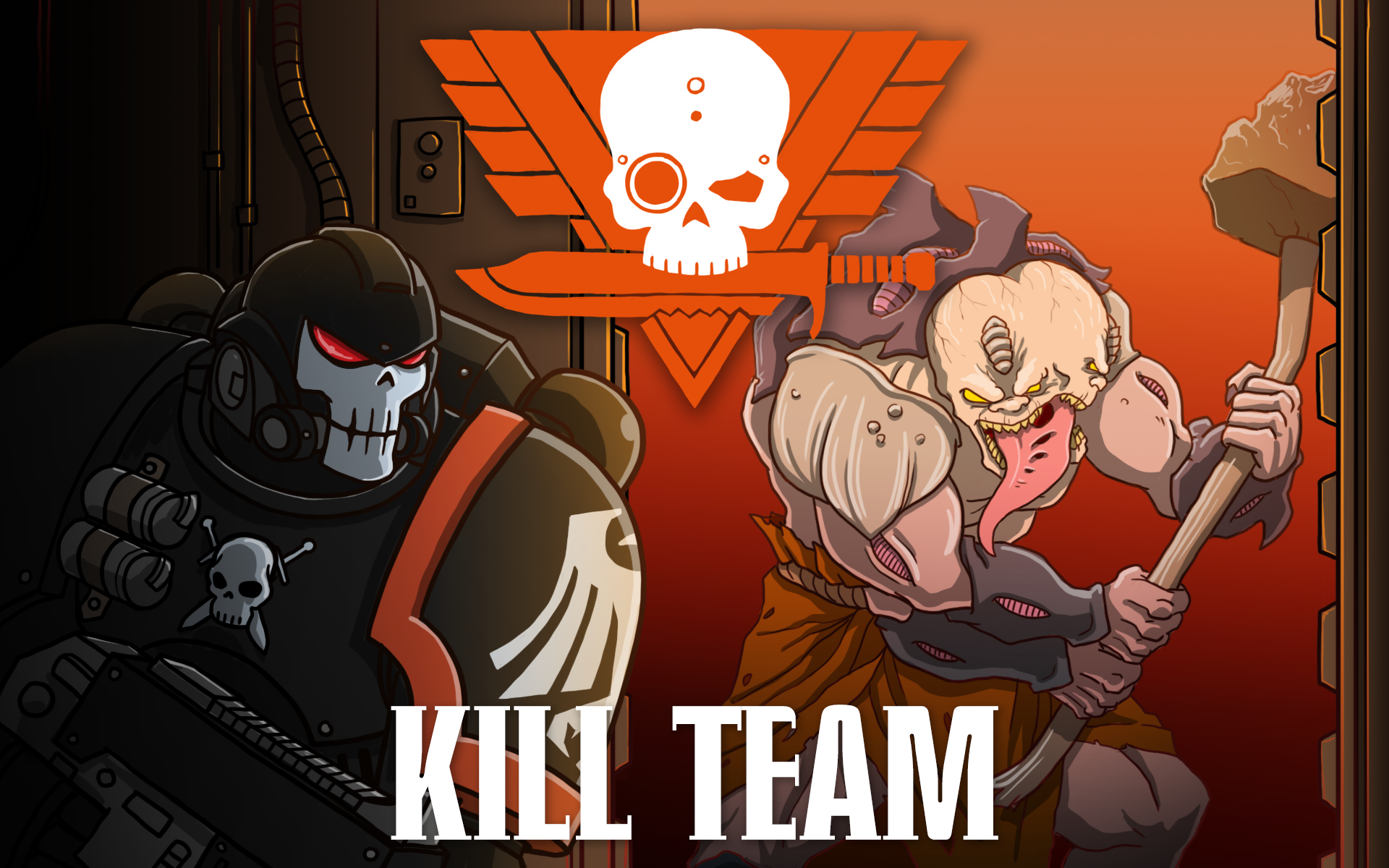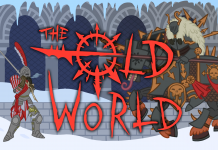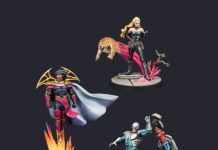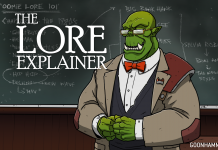Today we’re plunging into The Depths of Tredecimmia, the latest addition to the Exemplary Battles series. This free to download PDF focuses on the war for the namesake Tredecimmia City, on the planet Bodt, and the mechanical horrors that lie within.
The Lore
Eagle-eyed veterans of the Horus Heresy will remember the name from the previous first Edition Black Book releases, and will be well aware of its ill-fated association with the World Eaters legion. For those less familiar, Bodt served the World Eaters throughout the latter days of the Heresy as a de facto recruitment world, armoury, and military research centre. Unsurprisingly, this proved to be an irresistible target for the marauding Shattered Legions, culminating in the eventual destruction of the planet at the hands of a vengeful Autek Mor prior to the Siege of Terra.
This Exemplary Battle expands upon this established lore, and reframes Bodt as the starting point for some of the earliest Dark Mechanicum experiments shown within the wider Horus Heresy setting. Bodt is presented as a centre of eldritch innovation between daemon and machine, and the conflicts upon the planet are shown to be a fertile proving ground for testing these technologies against Astartes opponents.
In the original telling of the events on Bodt, a Shattered Legion force led by Autek Mor invaded the planet to wreak a bloody revenge, and while mentioning the input of the Imperial Fists peripherally, their role in the conflict was minimally expanded upon. The newest publication greatly expands on the role of the Imperial Fists during this war, and explores some of the brutal battles they faced upon the planet against the terrifying constructs of the Dark Mechanicum.
As a very entrenched Iron Hands and Mechanicum player, I was really looking forward to reading more about Autek Mor’s assault, and was very surprised to find that the focus had shifted towards the Imperial Fists so heavily. While the story was interesting, and the battle scenes superficially engaging, it did feel slightly strange to read about one of the few Iron Hand battles post-Istvaan 5 largely be represented as an Imperial Fist war.
I can’t help but feel that the drive for this was to continue to support newer players to this edition, who may (rightly or wrongly) view the Imperial Fists as the preeminent legion for the Loyalist cause. I do feel this was a really big missed opportunity given the relative paucity of information on the Iron Hands after the Dropsite Massacre.
Already I felt that we were off to a confused start and can but hope that the rest of the PDF improves from this reworked origin story.

Unleashing a Corrupted Engine
The primary focus of the new rules is the addition of the Corrupted Engine subtype to your armies.
These are generally presented as biochemical horrors developed by the Dark Mechanicum in secret, and unleashed upon the Loyalists as a weapon of last resort on Bodt.
Their selection is unlocked via the Praevian consul choice, and allows the controlling player to add one Corrupted Engine alongside this character into their army list. Crucially, this selection overwrites the usual Praevian choice of Automata Maniples, and you cannot RAW take a Corrupted Engine AND your redoubtable Castellax or Vorax in the same list.
If a second Praevian is chosen, this additional second character option will unlock an Automata unit as per the original rules presented in the Liber Astartes/Liber Hereticus books.
The Praevian option has been covered in previous articles within our Horus Heresy Tactica series, but as a reminder, they are essentially technologically-inclined Centurions with a comparable stat-line and wargear selection. For more high-tech legions such as the Iron Hands, Iron Warriors or Salamanders, they provide a great narrative opportunity to develop a custom robot wrangler and are usually a fun way to add the hard-hitting Automata unit subtype to your army.
In the context of a Corrupted Engine, this Character model won’t join the Corrupted Engine unit, and can be deployed safely elsewhere. I think this is a useful mechanic, as the units we’ll be covering wouldn’t likely be materially improved by the addition of a Toughness 4 Wound 2 character tagging along.
I’d view the Praevian as a simple “unlock” for your Corrupted Engine choice, and a necessary tax to add one of these behemoths to your army.
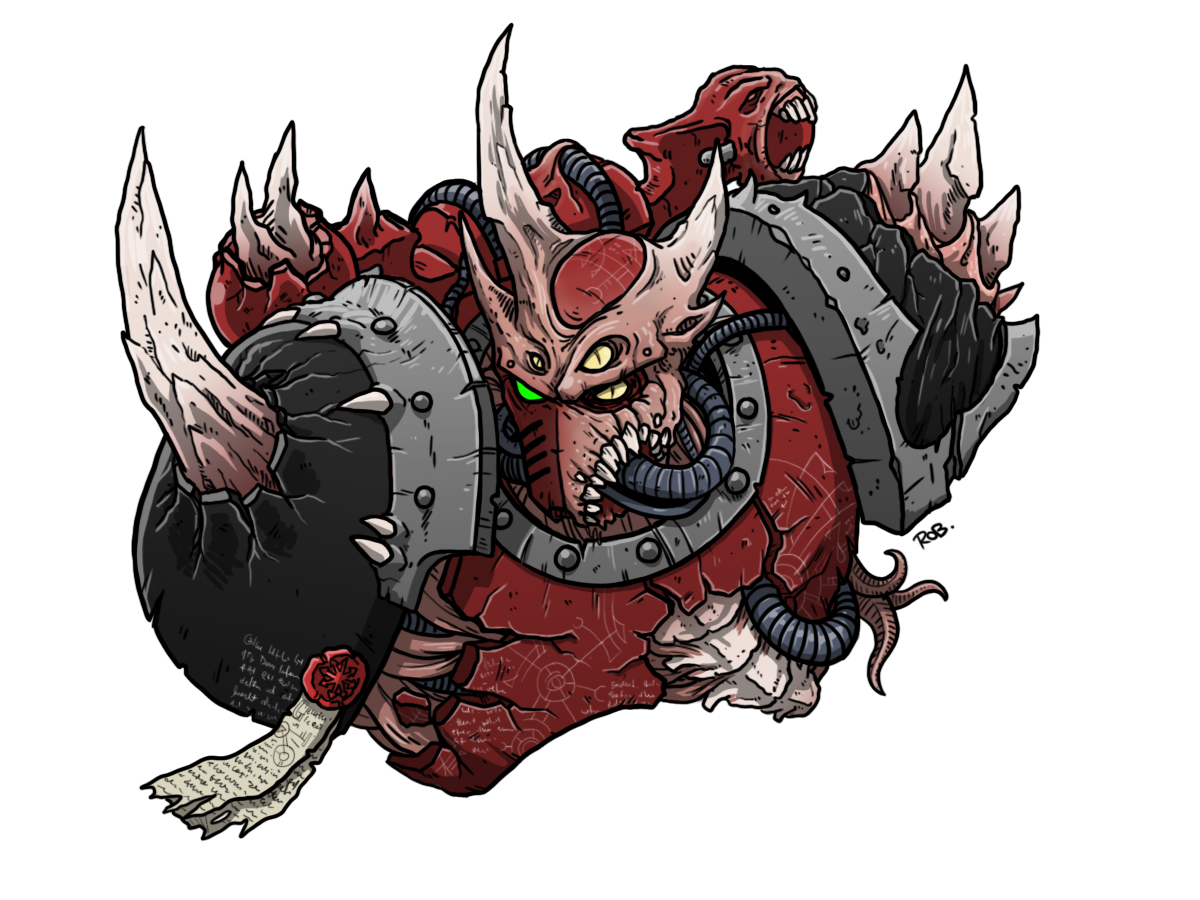
The Corrupted Engine Subtype
The Corrupted Engine subtype confers some interesting and helpful rules to maximise the battlefield impact of these models on the battlefields of the 30th Millennium:
- Units with this subtype gain Fear (1), or if lucky enough to already have this, garner a further +1 to the Fear (X) rule which they benefit from. I think Fear is an excellent USR, and one that you’ll generally find incidentally relevant in even the largest games of Horus Heresy. With leadership being a much more important mechanic in this edition, anything to reduce these statistics can be very useful to degrade the enemy’s plans. The ancillary benefit of Fear in the specific context of a Corrupted Engine is how resilient and mobile (more on this later!) that these are likely to be, meaning you are very likely to have the benefit of the “Fear bubble” for the entire game across a relatively wide area, which is often a challenge if relying on Infantry of sole Characters with Fear (X).
- As a result of the above, these units are also rather helpfully immune to Fear (X), negating its potential effects on your scary robot monsters.
- A Corrupted Engine also automatically passes Regroup tests, cannot choose to fail a Morale check, and in cases where they are required to Fall Back do not do so, but rather stay in the fight at the cost of D3 automatic wounds taken. I think this is probably a reasonable trade-off, as you’ll want to maximise your time in combat with these expensive units, and I suspect that in real terms, the chances of them being required to Fall Back is actually pretty low in practice.
Not everything is rosy however, and the Corrupted Engines do have a few drawbacks compared to non-daemonically infused mechanical platforms:
- Anything that affects the Corrupted subtype, also triggers against your Corrupted Engine. This makes the particularly vulnerable to (albeit relatively rare) units with Anathema, or anything bearing specific anti-Daemon weapons. Given the setting, I’d perhaps expect this list of weapons to extend further as the releases move our timeline towards the more Chaotic aspects of the final days on Terra.
- Similar to the above, Force remains an issue against Corrupted units, with successful Force wounds conferring Instant Death. Thankfully, Instant Death doesn’t directly confer onto these constructs, and instead will manifest as D3 wounds taken for each unsaved Instant Death wounds they receive. I think this is also pretty situational, but I would still recommend staying away from Librarians brandishing Force Axes!
- Understandably, given the eldritch horror they exude, Corrupted Engines cannot be joined by units, and by my reading, won’t be able to join any others with ease. They stand apart from your other forces as befitting their uniquely scary nature!
The overall palette of rules encompassed by the new Corrupted Engine subtype seems fair, and I think the drawbacks are generally pretty niche. I didn’t get the impression there was a glaring issue here which would make these unusable in “all comers” list for a narrative event or campaign weekend amongst friends.
If anyone can think of a weird interaction I’ve overlooked, please share in the comments!
The Aetheric Dominion
Now to the really narrative part of their rules, as each Corrupted Engine is blessed (or cursed…) by access to a specific Aetheric Dominion.
This upgrade will be familiar to anyone who has read the Daemon rules for Horus Heresy and achieves a similar goal in “marking” your construct to the specific Chaos powers that animates them.
Rather than the traditional four powers of Khorne, Nurgle, Slannesh, or Tzeentch, the Corrupted Engines are identified as either benefiting from either Heedless Slaughter or Malevolent Artifice.
Units will only ever confer one Aetheric Dominion bonus, and they cannot be in combined units with other models of another Aetheric Dominion. As is the recurring theme, I don’t think this is a particular drawback as functionally these models will be deployed independently as lone units on your battlefield and generally won’t be present in multiples or attached to Characters or Infantry units with an Aetheric Dominion.
The two current Aetheric Dominions showcase two variants of the powers exhibited by the Mechanicum infused Daemons present on Bodt:
- Heedless Slaughter represents the blasphemous fury of the warp unleashed in combat. In game terms, this helpfully improves their assault output by improving their Charge roll by +1, adding +1 to Combat Resolution in the Assault phase, and aids their Sweeping Advance by adding a further +1 inch to the distance. The downside, such as it is, is that your construct must declare a charge when able to, when within 8 inch range of an enemy unit. This doesn’t overrule the usual rules for shooting prior to a legal charge being declared. I’m not sure this is really a drawback. These units are all more than adequate in close combat and I think you’ll want to declare charges at 8 inch range or nearer. Helpfully, if two or more units are legal choices, the controlling player can pick which to target. So, from a strategic perspective, you’ll not readily be baited into a charge you wouldn’t otherwise with to attempt. I think this Aetheric Dominion is clearly a nod towards the more Khorne-infused constructs, which is a nice call-back to their pre-Horus Heresy release origins as largely Khorne-aligned Daemon engines in earlier editions of Warhammer 40’000.
- Malevolent Artifice conversely represents the otherworldly resilience and atavistic nature of these summoned Daemons, whether confined to an adamantium chassis or not. This is represented on the battlefield by improving their resilience to incoming damage, and allowing them to re-roll all failed Armour Saves when the Strength value of the attack is lower than their native Toughness value. This bonus won’t confer to Invulnerable saves unfortunately. I think this is a fantastic rule, as their high Toughness values will generally allow them to re-roll most failed Armour Saves, giving them a situational, but commonly triggered faux-Feel No Pain on multiple Wound, high Toughness models. I think in game terms, this will make them significantly better at dodging wounds from low Strength weaponry turned against them hoping to overwhelm their good Armour Saves via weight of fire. I’m looking at you Heavy Bolters, Autocannons, and Volkite Culverins. I also think this is another call-back to the original Chaos powers, and while a little less pox-ridden than we’d perhaps like, is a clear nod to Nurgle as the traditional Chaos archetype for making your Corrupted Engine a harder target to kill.
Selecting a Corrupted Engine
Now that we’re acquainted with the core interactions and benefits of the Corrupted Engine subtype, its past time to look at the specific constructs you’ll purchase as a new unit for your army.
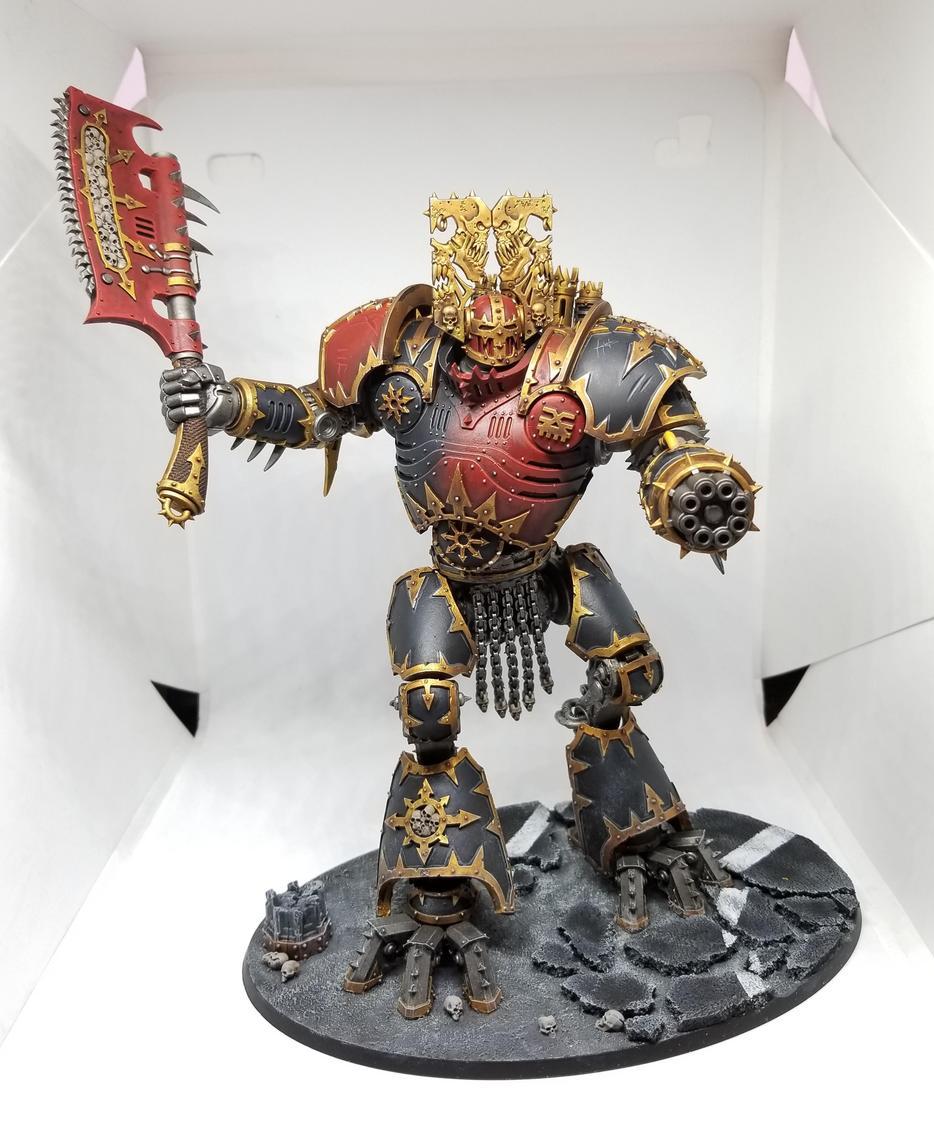
Kytan Daemon Engine
The Kytan is a Knight-equivalent unit, developed by the cursed Dark Mechanicum of Sarum. In keeping with its origins as a Knight, the Kytan towers over the opposition bother literally and figuratively with a more than decent Knight-like stat line and will occupy your Lord of War slot.
This platform confers a reasonable Movement 14 inches, relatively high within class Weapon Skill 6, and high Hull Points 8. I think these three stats probably give the clearest indication of its expected role in your army i.e. rapidly closing into close quarters combat, and then demonstrating the resilience to stay in the fight until your foes are obliterated. A Malefic Aegis save of 5+ helps with shrugging off any high Strength and low AP firepower that may be presented to counter the walker as it advances.
The Heedless Slaughter Dominion also helps with Charge distance, Combat Resolution and any Sweeping Advances, and should guarantee your large construct is sufficiently mobile to catch up the enemy in all relevant phases.
Hammer of Wrath (4) and Rampage (D3) add to the already healthy Attacks 4, meaning damage output is likely to be very high once you reach the target. The unit is equipped with the grotesquely and appropriately named Cleaver of Slaughter, throwing out Strength 10 AP 2 attacks aplenty. The addition of Brutal (3) and Shred synergise well with the high Weapon Skill, meaning in most instances this will outclass enemy Loyalist Knight-sized platforms or Dreadnoughts.
Longer ranged firepower is not the primary use of this construct, but the Kytan Gatling Cannon does give the model something to do when the enemy remains frustratingly out of reach. The Gatling Cannon looks well suited to thinning the ranks of enemy Infantry with an enormous Heavy 18 profile, associated with Pinning and Shell Shock (1). While I think this unit will be largely directed against other enemy Knight-class walkers, Super Heavy, or Dreadnought units, the addition of a Pinning Weapon on a model with Fear (1) and Shellshock (1) could make for some uncomfortably difficult Pinning Tests for your opponent to take. If nothing else, the huge cannon is very thematic for a Khorne-styled weapon, and will be great fun to roll up with that many dice involved!
The Kytan is a Traitor only unit, but again, I don’t think this is much of an issue as I can’t fathom why a Loyalist would want to add a walking temple of devotion to Khorne to their army.
I really like the Kytan as a choice, and think that conceptually the rules writing team has captured the close combat power and fury we should expect in a Khorne-styled Knight model. While it will be vulnerable to anti-tank firepower like all Knights, I think it will probably require such a significant investment in this for the enemy to bring down that it will probably work in the worst case as an excellent “Distraction Carnifex” and allow the rest of your army to close with the enemy battle line unmolested.
I think the Kytan will also work well in the face of enemy Knights or their equivalents, and looks to me to be better in most cases than the equivalent points-value Loyalist pick, even when you consider the purchase of a compulsory Centurion-level character.

(The crown demonstrates how great it is)
Greater Brass Scorpion
If the Kytan is a Knight, reimagined in gore-stained brass armour, then the Scorpion is very much the low-slung scuttling horror, designed to advance towards the foe in a flurry of close-ranged firepower before crushing the unlucky survivors with its deadly claws.
At first glance, the Greater Brass Scorpion looks to be similarly Khorne-themed, and shares the Heedless Slaughter Aetheric Dominion, Hammer of Wrath (4), and Rampage (D3) rules pack of the Kytan. The Scorpion is also protected by the 5+ Malefic Aegis save and also remains accessible only to Traitors.
The primary difference in the unit choice is the stat line, with a more conservative Movement 10, reduced Weapon Skill 5, and lower Attacks 3. To balance these changes, and to reflect its close firepower/support role, the Scorpion enjoys an improved Ballistic Skill 4. This is just as well, as the Scorpion is armed to the (literal) teeth with a turret mounted Scorpion Cannon, midline Despoiler cannon, and two front arc Hellmaw cannons.
The Scorpion cannon is best viewed as a mid-range and mid-strength upgrade on a Heavy Bolter, with Assault 9, Pinning and Shred. This is relatively useful as a fire support weapon against light Infantry, but given the uninspiring AP4, is unlikely to cause many wounds against 3+ saves. For this, you’ll need the Despoiler cannon. This is a far more useful profile for deleting power armoured formations, with the weapon firing Strength 10 AP 3 blasts. The profile is further buffed by Shred, with Rending (5+) giving it some utility against 2+ save opponents. The very high Strength will make sure any wounds are likely to be Instant Death, and Brutal (3) really reduces the probability of successful Invulnerable saves being tanked onto particularly brave characters. Of the three weapon systems, I found the Hellmaw cannon the most confusing, with a Strength 7 AP 4 profile, it’s analogous to an Autocannon, but deployed on a Torrent (6 inch) flame template. I think you’ll have to be very close to the enemy for this to have any utility, but I guess it will support your Scorpion Cannon against swarms of lighter Infantry. Perhaps if Militia or Solar Auxilla are prevalent in your local meta, consider this as a useful option for Traitor armies.
The Scorpion excels in close combat as you’d expect from the Khorne-styled model, with dual Hellcrusher Claws delivering reliable Strength 10 AP2 wounds, further buffed by Brutal (2) to negate high quality Invulnerable saves. Sunder will provide some anti-tank damage in a pinch, but I think more often than not you’ll be deploying this unit against high quality elite infantry such as Terminators, and making a mockery of their superior armour saves. The slightly lower Weapon Skill will still let the Scorpion fight at parity with most Dreadnought chassis, making it a viable counter-threat if your opponent leans into Contemptor-heavy builds.
I think the rules for the Greater Brass Scorpion certainly make it a viable choice, but I do wonder if the high points cost and largely anti-infantry shooting profiles make it a weaker choice than the Kytan, or other Legion-specific Lord of War options. The model is a bona fide classic however, and this release does provide an excuse to make the model purchase if looking for a unique model to add to a Traitor faction army.
I think that stylistically this model would work well in any World Eater, Word Bearer or Sons of Horus army, and I’m looking forward to seeing modeller’s iterate on the traditional red and gold paint scheme.

Blood Slaughterer
We complete the trifecta of Khorne-themed constructs with the rarely-seen Blood Slaughterer miniature. I’ve never seen these in real life, and don’t know anyone who has/had one of these models. I was really surprised to see that they were still purchasable from Forgeworld, and that both weapon variations of the unit were retained in the catalogue. Given the amount of core units that have been unceremoniously discontinued, I did find that a little perplexing!
If the Kytan and Greater Brass Scorpion are your Knight-equivalents, then these glorious beasts are your Dreadnought replacements. Interestingly, this is the only Corrupted Engine choice that can be deployed as a unit, with a unit of 3 being purchasable for one selection. They also move away from the Lord of War slot and occupy the less contested Fast Attack option. Unfortunately, no point reduction is available as you increase the unit size, which I found a little surprising, as I don’t think you’d be inclined to take a single model sized unit of these.
The Slaughterer stat line is similar to a modified Castraferrum profile, with Weapon Skill 5, Ballistic Skill 3, and the lower Strength 6 and Toughness 6. These models also suffer from a lower Armour Save 3+, and an inferior Malefic Aegis 6+. They are improved offensively by the Heedless Slaughter Aetheric Dominion, Move Through Cover and a Movement 9 to help get into combat.
Their stock options are entirely close combat orientated when selected, with Strength 8 AP 3 Slaughterer Blades being the main option. With Attacks 4, they will provide a reasonable option against 3+ Infantry blocks, which synergises well with an in built Furious Charge (1) on the profile. The model can upgrade to a free Impaler Harpoon for some modest ranged firepower, but I don’t think you’ll be in a hurry to pick up a short ranged Strength 6 AP 3 shot. Even if it does have the awesomely thematic Impale rule to reduce enemy Initiative if wounding successfully.
While I’m trying hard not to be negative, I’m not sure that these are particularly worthwhile as a choice. They would appear to be a focused Dreadnought-style close combat unit, but they are largely worse in most regards to the Contemptor in this role, unless multiples are taken as a larger combined unit. At which point, they start to compete with more rounded choices such as the Leviathan, or the previously discussed Knight-styled constructs. I think they’re arguably worse than taking 2-3 Castraferrum chassis, and in that context, you wouldn’t require the additional Praevian tax to unlock. This is a shame really, as the models are stunning, and any excuse to field one (or three) would’ve been gratefully received.
A swing and a miss compared with the Lord of War options.

Decimator
The final Corrupted Engine is to the Leviathan, as the Blood Slaughterer is to the Dreadnought. The lore for this mysterious contraption implies that the Dark Mechanicum have been sufficiently concerned around the Terra-developed Leviathan to bring their own larger construct into the war.
The Decimator occupies your Heavy Support choice, and as such, is in a hotly contested spot of the Legion roster.
Generally, “good” Heavy Support offers high point’s efficiency, high fire power output, and good resilience against return fire. In my own list design, the usual yard stick for any Heavy Support choice is how favourably they compare with a Leviathan, and whether the alternate choice offers something unique a Leviathan cannot achieve.
In stat line, the Decimator isn’t too dissimilar to a Leviathan, with a high Strength 8 and Toughness 7 base. Wounds 7 and a 2 + save (which we’ll reroll against Strength 6 and below attacks with Malevolent Artifice) should make it resilient enough to last 6 turns of bloody warfare. Furious Charge (2) and Hammer of Wrath (2) synergise well with the high Attack 5 value, meaning you are chucking out a lot of potential hits in the first round of combat. I like the combination of Hammer of Wrath (2) and Strength 8, as I think this can potentially cause a few free wounds against high Toughness opponents for simply charging, which is something this model wants to do anyway!
Armaments for the Decimator are similar to a Leviathan Dreadnought in style, allowing you to swap out the Strength 8 AP 2 Brutal (3) claw attacks for either a Butcher Cannon or Soulburner Petard. The Butcher Cannon is similar to the Stormcannon on the Leviathan chassis, and brings a similar autocannon profile Strength 7 AP 4 with Rending (6+). With 3 shots and Twin-linked, this is a viable option if you felt strongly that you wanted to add some ranged firepower to the Corrupted Engine, although given the utility in the Decimator claws against almost every target, I’m not sure why you’d want to pay additional points to reduce its close combat output. The Soulburner is similarly available as an upgrade, and allows you to arm the construct with a slightly strange not-Plasma Cannon blast with Breaching and Fleshbane. I’m not sure this is a particularly strong option given its base AP4, making it almost always worse than the equivalent Leviathan options.
I think in a vacuum the Decimator is probably a fun choice, but strictly worse than the comparable Leviathan build with a Siege Claw and Drill. While theoretically more resilient, I think that you’re going to miss the higher Strength output from a Leviathan, and also regret not having the utility of the superior additional weapon systems on the hull (such as Volkite arrays) or close ranged Phosphex for sneaky AP2 wounds before you charge.
The model is, as with all these choices, stunning. It really evokes the weirdly ancient evil vibe that Chaos does so well, and it would be a great addition to more debased Legion such as the Emperor’s Children or Death Guard. I suspect we’ll not see many of these in the wild, but will be delighted when we do!
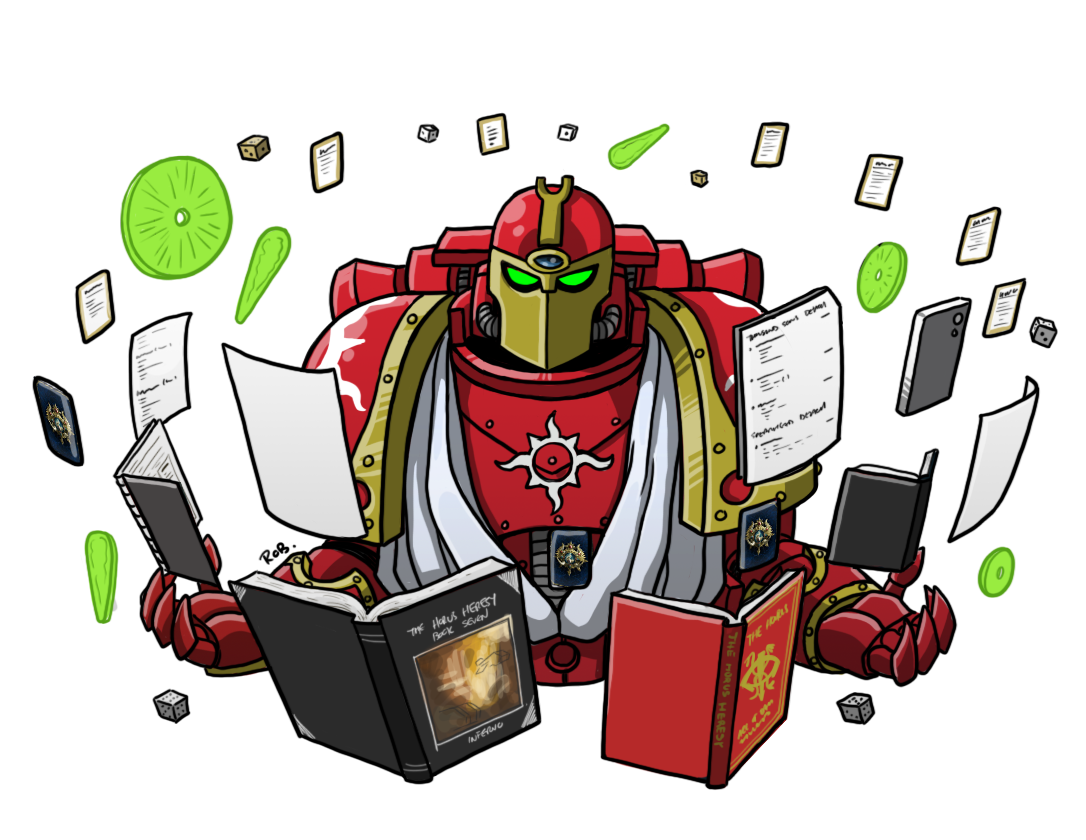
Cybertheurgic Arcana
But wait! You’ve forgotten this!
Well, not really. The discussion above demonstrates how to add the Corrupted Engine subtype to a balanced Legion army list, and how these roughly compare to the equivalent Legion choices.
The additional Arcana reflects a new rising power within the Mechanicum instead, and how the more esoteric studies of the blackest chaos magicks can allow a brave Magos enhanced power over their constructs. So, for most Legion players, it’ll be irrelevant ephemera.
For completeness however, the Arcana unlocks a Cybertheurgic Rite and Cybertheurgic Weapon as usual:
- The Animatus Malevolence allows the Cybertheurgist to target a friendly Corrupted Engine and either move them towards the enemy a number of inches comparable to the Corrupted Engine’s Initiative value, improve the a unit’s Invulnerable Save by +1, or add +1 to the Weapon Skill and Initiative to a target unit.
- If a successful check is made before using the power two options can be applied to the unit.
- The Amthea Excrusis is essentially a powered-up Volkite Charger profile, offering an 18 inch, Strength 5 AP 3 Assault three weapon with Deflagrate and Blind. While providing a nice anti-tank option, the range is very short here, and I do wonder whether it’s very likely your Magos will be wandering around close enough to tanks for it to be relevant. AP3 is decent on the face of it against 3+ Infantry, but given most Magos already have access to AP2 shooting attacks, I’m not sure this is a niche that needs covered by an Arcana.
I think the immediate barrier here for any Automata-inclined gamer is the overall low power level of the Mechanicum army list, and whether this is a set of additional rules that will be frequently used by them. As a recovering Cybernetica player, the Arcana struck me as a neat narrative option, but not something one would construct a game plan around. I feel that the Cybertheurgic power in particular is a “win more” choice, as I suspect the Lord of War choices from the Corrupted Engine list won’t require the additional buffs to be effective, and for those that do such as the Slaughterer, it’s even more points investment on an already expensive model.
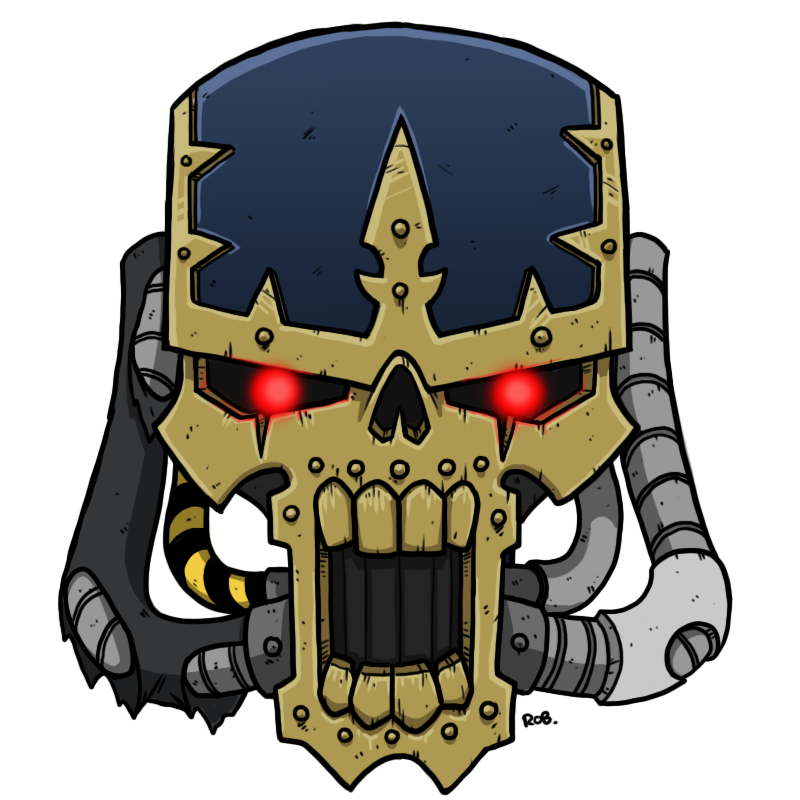
Closing Thoughts
There’s an odd tension in the most recent Exemplary Battle PDF.
For me, the lore aspects miss the mark by shoehorning in the Imperial Fists into another centre stage role when it was an easy opportunity to showcase some of the less frequently seen and appropriate technological Legions. I’m not particular interested in reading even more about a fairly random Imperial Fist character, and the action scenes where satisfying without being exceptional. I can’t see me returning to the PDF for a lore re-read anytime soon.
Conversely, the actual units in the PDF are really well conceived and executed narrative choices for a Traitor army, and provide a brilliant opportunity to get some older and much-loved models back onto the table. Each has a really evocative narrative piece attached, and the upgrades and rules combinations work very well to represent these terrifying amalgams of daemon and machine.
From a purely rules perspective, I think the Lord of War slot seems the best route to go down if someone wants to add one of the Corrupted Engines to an existing army, and the two choices offered provide a reasonable alternative to a Questoris or Mechanicum Knight chassis. I was disappointed in the Blood Slaughterers and Decimator, and think you’re probably best staying to the tried and true Contemptor and Leviathan hulls instead.
Overall, I think it’s very unlikely we’ll see many of these older units in the wild at events or campaign days, which seemed like the entire point of this release.
Maybe you’ll prove me wrong and take this as inspiration to unleash some mechanical horror on the unsuspecting Loyalist forces in your friendly local gaming store!

![[40k] Competitive Innovations in 10th: Death Beckons pt.3](https://d1w82usnq70pt2.cloudfront.net/wp-content/uploads/2020/01/Analysis_Banner.png)
